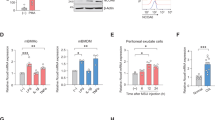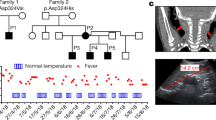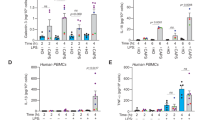Abstract
Mutations in NLRP3 (CIAS1) are identified in a continuum of related inflammatory disorders, known as cryopyrinopathies since NLRP3 codes for the protein cryopyrin. Approximately 40% of patients with classic presentation lack mutations in the coding region of NLRP3 suggesting heterogeneity or epigenetic factors. Cryopyrin is a key regulator of proinflammatory cytokine release. Therefore, variations in the NLRP3 promoter sequence may have effects on disease state in patients with cryopyrinopathies and other inflammatory diseases. In this report, we confirmed three 5′-untranslated region splice forms with two separate transcriptional start sites, and identified potential promoter regions and six new DNA promoter variants. One variant is unique to a mutation negative cryopyrinopathy patient and increases in vitro gene expression. Additional studies can now be performed to further characterize the NLRP3 promoter and sequence variants, which will lead to better understanding of the regulation of NLRP3 expression and its role in disease.
This is a preview of subscription content, access via your institution
Access options
Subscribe to this journal
Receive 6 digital issues and online access to articles
$119.00 per year
only $19.83 per issue
Buy this article
- Purchase on Springer Link
- Instant access to full article PDF
Prices may be subject to local taxes which are calculated during checkout


Similar content being viewed by others
References
Harton JA, Linhoff MW, Zhang J, Ting JP . Cutting edge: CATERPILLER: a large family of mammalian genes containing CARD, pyrin, nucleotide-binding, and leucine-rich repeat domains. J Immunol 2002; 169: 4088–4093.
Feldmann J, Prieur AM, Quartier P, Berquin P, Certain S, Cortis E et al. Chronic infantile neurological cutaneous and articular syndrome is caused by mutations in CIAS1, a gene highly expressed in polymorphonuclear cells and chondrocytes. Am J Hum Genet 2002; 71: 198–203.
Hoffman HM, Mueller JL, Broide DH, Wanderer AA, Kolodner RD . Mutation of a new gene encoding a putative pyrin-like protein cause familial cold autoinflammatory syndrome and Muckle–Wells syndrome. Nat Genet 2001; 29: 301–305.
Hoffman HM, Wanderer AA, Broide DH . Familial cold autoinflammatory syndrome: phenotype and genotype of an autosomal dominant periodic fever. J Allergy Clin Immunol 2001; 108: 615–620.
Muckle TJ . The ‘Muckle–Wells’ syndrome. Br J Dermatol 1979; 100: 87–92.
Prieur AM, Griscelli C, Lampert F, Truckenbrodt H, Guggenheim MA, Lovell DJ et al. A chronic, infantile, neurological, cutaneous and articular (CINCA) syndrome. A specific entity analysed in 30 patients. Scand J Rheumatol Suppl 1987; 66: 57–68.
Neven B, Callebaut I, Prieur AM, Feldmann J, Bodemer C, Lepore L et al. Molecular basis of the spectral expression of CIAS1 mutations associated with phagocytic cell-mediated autoinflammatory disorders CINCA/NOMID, MWS, and FCU. Blood 2004; 103: 2809–2815.
Manji GA, Wang L, Geddes BJ, Brown M, Merriam S, Al-Garawi A et al. PYPAF1, a PYRIN-containing Apaf1-like protein that assembles with ASC and regulates activation of NF-kappa B. J Biol Chem 2002; 277: 11570–11575.
Rosengren S, Hoffman H, Bugbee W, Boyle D . Expression and regulation of cryopyrin and related proteins in rheumatoid arthritis synovium. Ann Rheum Dis 2005; 64: 708–714.
Omi T, Kumada M, Kamesaki T, Okuda H, Munkhtulga L, Yanagisawa Y et al. An intronic variable number of tandem repeat polymorphisms of the cold-induced autoinflammatory syndrome 1 (CIAS1) gene modifies gene expression and is associated with essential hypertension. Eur J Hum Genet 2006; 14: 1295–1305.
Mahr S, Burmester GR, Hilke D, Göbel U, Grützkau A, Häupl T et al. Cis- and trans-acting gene regulation is associated with osteoarthritis. Am J Hum Genet 2006; 78: 793–803.
Novak N, Yu CF, Bussmann C, Maintz L, Peng WM, Hart J et al. Putative association of a TLR9 promoter polymorphism with atopic eczema. Allergy 2007; 62: 766–772.
Ge YW, Lahiri DK . Regulation of promoter activity of the APP gene by cytokines and growth factors: implications in Alzheimer's disease. Ann NY Acad Sci 2002; 973: 463–467.
Pesole G, Grillo G, Larizza A, Liuni S . The untranslated regions of eukaryotic mRNAs: structure, function, evolution and bioinformatic tools for their analysis. Brief Bioinform 2000; 1: 236–249. Review.
Schug J . Using TESS to predict transcription factor binding sites in DNA sequence. Current Protocols in Bioinformatics, version 1. Wiley, 2003, pp 2.6.1–2.6.9.
Gabay C, Smith MF, Eidlen D, Arend WP . Interleukin 1 receptor antagonist (IL-1Ra) is an acute-phase protein. J Clin Invest 1997; 99: 2930–2940.
Rosenstiel P, Huse K, Franke A, Hampe J, Reichwald K, Platzer C et al. Functional characterization of two novel 5′ untranslated exons reveals a complex regulation of NOD2 protein expression. BMC Genom 2007; 8: 472.
Clarke S, Gordon S . Myeloid-specific gene expression. J Leukoc Biol 1998; 63: 153–168. Review.
Skalnik DG . Transcriptional mechanisms regulating myeloid-specific genes. Gene 2002; 284: 1–21. Review.
Pugh BF, Tjian R . Transcription from a TATA-less promoter requires a multisubunit TFIID complex. Genes Dev 1991; 5: 1935–1945.
Aksentijevich I, Putnam C, Remmers EF, Mueller JL, Le J, Kolodner RD et al. The clinical continuum of cryopyrinopathies: novel CIAS1 mutations in North American patients and a new cryopyrin model. Arthritis Rheum 2007; 56: 1273–1285.
Macaluso F, Nothnagel M, Parwez Q, Petrasch-Parwez E, Bechara FG, Epplen JT et al. Polymorphisms in NACHT-LRR (NLR) genes in atopic dermatitis. Exp Dermatol 2007; 16: 692–698.
Steinke JW, Barekzi E, Hagman J, Borish L . Functional analysis of -571 IL-10 promoter polymorphism reveals a repressor element controlled by sp1. J Immunol 2004; 173: 3215–3222.
Pietrzak M, Puzianowska-Kuznicka M . p53-dependent repression of the human MCL-1 gene encoding an anti-apoptotic member of the BCL-2 family: the role of Sp1 and of basic transcription factor binding sites in the MCL-1 promoter. Biol Chem 2008; 389: 383–393.
Zhan M, Yu D, Liu J, Glazer RI, Hannay J, Pollock RE . Transcriptional repression of protein kinase Calpha via Sp1 by wild type p53 is involved in inhibition of multidrug resistance 1 P-glycoprotein phosphorylation. J Biol Chem 2005; 280: 4825–4833.
Author information
Authors and Affiliations
Corresponding author
Additional information
Supplementary Information accompanies the paper on Genes and Immunity website (http://www.nature.com/gene)
Supplementary information
Rights and permissions
About this article
Cite this article
Anderson, J., Mueller, J., Misaghi, A. et al. Initial description of the human NLRP3 promoter. Genes Immun 9, 721–726 (2008). https://doi.org/10.1038/gene.2008.66
Received:
Revised:
Accepted:
Published:
Issue Date:
DOI: https://doi.org/10.1038/gene.2008.66
Keywords
This article is cited by
-
Toward targeting inflammasomes: insights into their regulation and activation
Cell Research (2020)
-
Schnitzler’s syndrome - a novel hypothesis of a shared pathophysiologic mechanism with Waldenström’s disease
Orphanet Journal of Rare Diseases (2019)
-
Zur Genetik der Cryopyrin-assoziierten periodischen Syndrome
Zeitschrift für Rheumatologie (2017)
-
The kinase activity of PKR represses inflammasome activity
Cell Research (2016)
-
Activation and regulation of the inflammasomes
Nature Reviews Immunology (2013)



